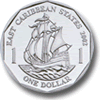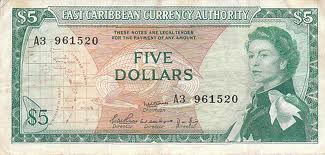|


The East Caribbean dollar (sign: $; code: XCD) is the currency of eight of the nine members of the Organisation of Eastern Caribbean States (the one exception being the British Virgin Islands). It has existed since 1965, being the successor to the British West Indies dollar, and it is normally abbreviated with the dollar sign $ or, alternatively, EC$ to distinguish it from other dollar-denominated currencies. The EC$ is subdivided into 100 cents. It has been pegged to the United States dollar since 1976 and the exchange rate is currently at US$1 = EC$2.70.
States using the EC$
Six of the states using the EC$ are independent states: Antigua and Barbuda, Dominica, Grenada, Saint Kitts and Nevis, Saint Lucia, and Saint Vincent and the Grenadines. The other two are British overseas territories: Anguilla and Montserrat. These states are all members of the Eastern Caribbean Currency Union. The only OECS member not using the East Caribbean dollar as their official currency is the British Virgin Islands. The British Virgin Islands were always problematic for currency purposes due to their proximity to the Danish West Indies which became the US Virgin Islands in 1917. Officially, the British Virgin Islands used to use sterling, but in practice the situation was a lot more complicated and involved the circulation of Francs[clarification needed] and US dollars. In 1951, the British Virgin Islands adopted the British West Indies dollar which at that time operated in conjunction with the sterling coinage, and in 1961 they changed over officially to the US dollar, no doubt due to the close proximity of the US Virgin Islands. British Guiana and Barbados had previously been members of this currency union but withdrew in 1966 and 1972 respectively. Trinidad and Tobago had been a member of the earlier British West Indies currency union, but withdrew in 1964.
The combined population of the EC$ area is close to 600,000 (2005 and 2006 census and estimates), which is comparable to Montenegro or the city of Washington, D.C..
Queen Elizabeth II appears on the banknotes and also on the obverse of the coins. She is the head of state of all the states and territories using the EC$, except for Dominica. Dominica is nevertheless a member of the Commonwealth of Nations which recognises Queen Elizabeth II as Head of the Commonwealth.
History
Queen Anne's proclamation of 1704 introduced the gold standard to the British West Indies, putting the West Indies about two hundred years ahead of the East Indies in this respect. Nevertheless, silver pieces of eight continued to form an important portion of the circulating coinage right up until the late 1870's. In 1822, the British government coined 1/4, 1/8, and 1/16 fractional 'Anchor dollars' for use in Mauritius and the British West Indies (but not Jamaica). A few years later copper fractional dollars were coined for Mauritius, Sierra Leone, and the British West Indies.
The first move to introduce British sterling silver coinage to the colonies came with an imperial order-in-council dated 1825. This move move was inspired by a number of factors. The United Kingdom was now operating a very successful gold standard in relation to the gold sovereign that was introduced in 1816, and there was a desire to extend this system to the colonies. In addition to this, there was the fact that the supply of Spanish dollars (pieces of eight) had been cut off as a result of the revolutions in Latin America where most of the Spanish dollars were minted. The last Spanish Dollar was in fact minted at Potosi in 1825. There was now a growing desire to have a stable and steady supply of British shillings everywhere the British drum was beating. The 1825 order-in-council was largely a failure because it made sterling silver coinage legal tender at the unrealistic rating in relation to the Spanish dollar of $1 = 4 shillings and 4 pence. Interestingly it did succeed in Jamaica, Bermuda, and British Honduras due to the fact that the authorities in those territories set aside the official ratings and used the more realistic rating of $1 = 4 shillings. The reality of the rating between the dollar and the pound was based on the silver content of the Spanish pieces of eight as compared to the gold content of the British gold sovereign.
A second imperial order-in-council was passed in 1838 with the correct rating of $1 = 4shillings 2pence. In the years following the 1838 order-in-council, the British West Indies territories began to enact local legislation for the purposes of assimilating their monies of account with the British pound sterling. Gold discoveries in Australia in 1851 drove the silver dollar out of the West Indies, but it returned again with the great depreciation in the value of silver that followed with Germany's transition to the gold standard between 1871 and 1873. In the years immediately following 1873, there was a fear that the British West Indies might return to a silver standard. As such, legislation was passed in the individual territories to demonetize the silver dollars. Even though the British coinage was also silver, it represented fractions of the gold sovereign and so its value was based on a gold standard.
During this period, and into the nineteenth century, accounts could be kept in either dollars or sterling. Jamaica, Bermuda, and the Bahamas preferred to use sterling accounts whereas British Guiana used dollar accounts. British Guiana used dollar accounts for the purpose of assisting in the transition from the Dutch guilder system of currency to the British pound sterling system. In the Eastern Caribbean territories the private sector preferred to use dollar accounts whereas the government preferred to use sterling accounts. In some of the Eastern Caribbean territories, notes were issued by various private banks, denominated in dollars equivalent to 4 shillings 2 pence. See Antigua dollar, Barbadian dollar, Dominican dollar, Grenadan dollar, Guyanese dollar, Saint Kitts dollar, Saint Lucia dollar, Saint Vincent dollar and Trinidad and Tobago dollar.
In 1949, the British government formalized the dollar system of accounts in British Guiana and the Eastern Caribbean territories by introducing the British West Indies dollar (BWI$) at the already existing conversion rate of $4.80 per pound sterling (or $1 = 4 shillings 2 pence). It was one of the many experimental political and economic ventures tested by the British government to form a uniform system within their British West Indies territories. The ISO 4217 code of the currency was XBWD. The symbol "BWI$" for frequently used and the currency was known verbally as the "Beewee" (slang for British West Indies) dollar. In 1951, the British Virgin Islands joined the arrangement, but this led to discontent because that territory was more naturally drawn to the currency of the neighbouring US Virgin Islands. In 1961, the British Virgin Islands withdrew from the arrangement and adopted the US dollar.
Until 1955, the BWI$ existed only as banknotes in conjunction with sterling fractional coinage. Decimal coins replaced the sterling coins in 1955. These decimal coins were denominated in cents, with each cent being worth one halfpenny in sterling.
In 1958, the West Indies Federation was established and the BWI$ was its currency. However, although Jamaica (including the Cayman Islands and the Turks and Caicos Islands) was part of the West Indies Federation, it did not adopt the BWI$. Jamaica, the Cayman Islands, and the Turks and Caicos Islands were already long established users of the sterling accounts system of pounds, shillings, and pence.
In 1964 Trinidad and Tobago withdrew from the currency union (adopting the Trinidad and Tobago dollar) and soon the "BWI$" dollar lost its regional support.
In 1965, the British West Indies dollar of the now defunct West Indies Federation was replaced at par by the East Caribbean Dollar and British Guiana withdrew from the currency union the following year. Barbados withdrew from the currency union in 1972.
Between 1965 and 1983, the Eastern Caribbean Currency Authority issued the EC$, with banknotes from 1965 and coins from 1981. The EC$ is now issued by the Eastern Caribbean Central Bank, based in the city of Basseterre, in Saint Kitts and Nevis. The bank was established by an agreement (the Eastern Caribbean Central Bank Agreement) signed at Port of Spain on July 5, 1983.
The exchange rate of $4.80 = £1 sterling (equivalent to the old $1 = 4s 2d) continued right into up until 1976 for the new Eastern Caribbean dollar.
For a wider outline of the history of currency in the region see Currencies of the British West Indies.
Coins
Until 1981, the coins of the BWI$ circulated. In 1981, a new series of coins was introduced in denominations of 1, 2, 5, 10 and 25 cents and 1 dollar. The round, aluminium bronze dollar coin was replaced in 1989 with a decagonal, cupro-nickel type. Higher denominations exist, but these were issued only as medal-coins.
Banknotes
In 1965, the Eastern Caribbean Currency Authority issued banknotes in denominations of 1, 5, 20 and 100 dollars. The first issues in the name of the Eastern Caribbean Central Bank in 1985 were of the same denominations, with the addition of 10 dollar notes. The last 1 dollar notes were issued in 1989 and 50 dollar notes were introduced in 1993.
The text on this page has been made available under the Creative Commons Attribution-ShareAlike License and Creative Commons Licenses
| 